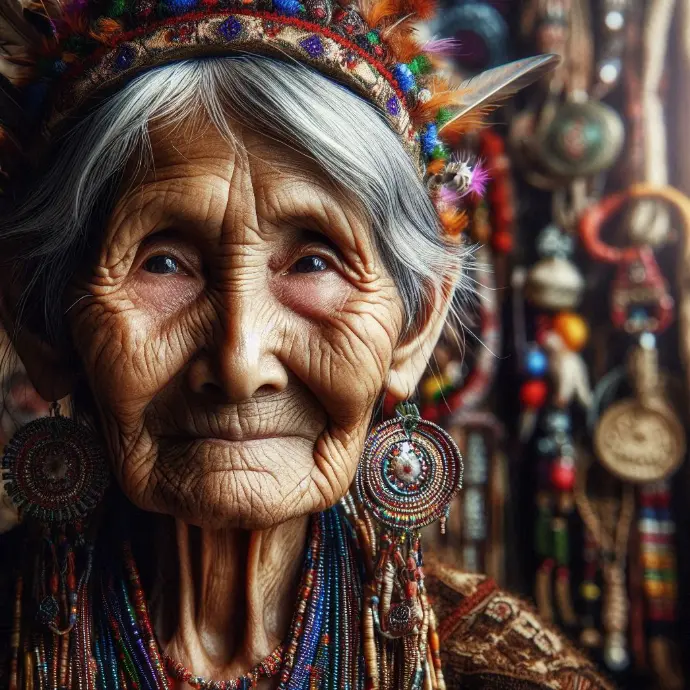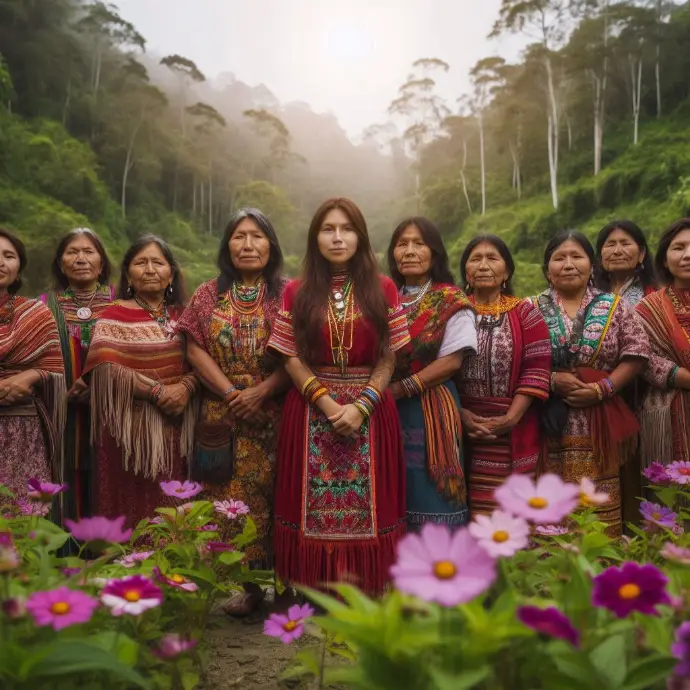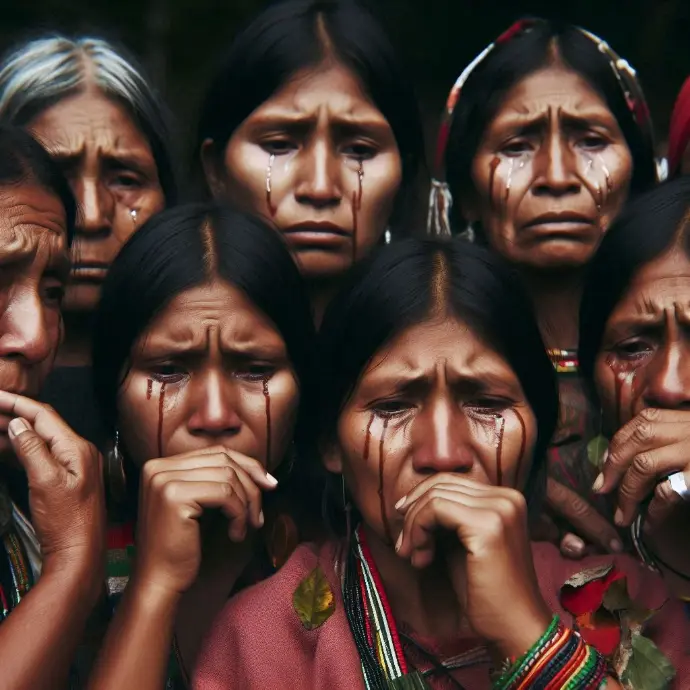
The fight for life: The case of forced sterilizations of indigenous women
On our website, we delve into the complex world of global human rights to thoroughly analyze cases such as forced sterilizations of indigenous women.
Discover how these practices impact the lives of indigenous communities and the ongoing struggle for justice.
Join the exploration and debate on this highly relevant topic!
Introduction
In the context of the human rights of indigenous women, it is essential to analyze the impact of forced sterilizations in these communities. This emblematic case not only reveals violations of the fundamental rights of a specific group, but also has significant repercussions in the field of human rights at a global level.
Indigenous women have historically faced systematic discrimination and violations of their fundamental rights. The intersectionality of gender and ethnicity has generated a situation of disadvantage that has resulted in multiple forms of oppression. For decades, indigenous women have fought for the recognition of their reproductive rights, political participation and access to justice, among other aspects.
The lack of recognition of the rights of indigenous women has perpetuated their marginalization and exclusion in numerous social, political and economic contexts. Although significant progress has been made in the promotion and protection of the human rights of indigenous women, important challenges remain, as evidenced by the case of forced sterilizations.
Forced sterilizations represent a clear violation of the reproductive rights of indigenous women, and are rooted in a context of systematic discrimination and structural inequality. This emblematic case is a powerful reminder of the urgent need to address human rights violations against indigenous women from a comprehensive perspective based on respect for their autonomy and dignity.
The impact of forced sterilizations on indigenous communities is devastating, as it not only affects women individually, but also has consequences at the community level. These coercive practices not only threaten the physical and psychological integrity of women, but also undermine the social cohesion and cultural continuity of indigenous communities.
Forced sterilizations create a deep rupture in the social fabric of indigenous communities, by attacking their reproductive capacity and autonomy. In addition, these practices contribute to the perpetuation of stereotypes and prejudices that dehumanize indigenous women, affecting their self-esteem and their position in society.
The trauma caused by forced sterilizations persists over time, impacting not only the women directly affected, but also future generations. The psychological, emotional and physical consequences of these human rights violations represent an additional burden for indigenous communities, which already face multiple forms of discrimination and exclusion.
The relevance of the case of forced sterilizations of indigenous women transcends national borders and is part of the context of global human rights. This case exemplifies the intersectionality of human rights violations, by highlighting the violation of reproductive rights, gender discrimination and the marginalization of indigenous communities.
Furthermore, this case represents a call to attention on the need to address human rights violations from an intersectional perspective, which recognizes the complexity of experiences of oppression and discrimination. The fight for justice and reparation in this case is essential to set a precedent in the protection of the human rights of indigenous women around the world.
The visibility of this case at the international level is crucial to raise awareness about the human rights violations faced by indigenous women, as well as to promote the adoption of concrete measures at the global level to prevent and punish these abusive practices.
Background of forced sterilizations of indigenous women
The history of forced sterilization practices in indigenous communities is a topic that has generated controversy and has left an indelible mark on the fight for human rights. For decades, indigenous women in different parts of the world have been subjected to sterilizations without their consent, as part of state policies or birth control programs. These practices, which have been described as a form of genocide, have deeply affected indigenous communities, generating a devastating impact on the lives of the affected women and their communities in general.
Forced sterilizations of indigenous women have been used as a tool of domination and control by governments and other entities, with the aim of reducing the indigenous population and weakening their cultural identity. This type of practice has been repeatedly denounced by human rights organizations, which have sought to make visible and combat this flagrant violation of the fundamental rights of indigenous women.
The history of forced sterilizations of indigenous women is a stark reminder of the injustices these communities have faced over time, and is an urgent call to action to ensure that these abuses are not repeated in the future.
Laws and regulations related to forced sterilization are essential to protect the reproductive rights of indigenous women and prevent abuses against them. At the international level, instruments such as the Universal Declaration of Human Rights and the Convention on the Elimination of All Forms of Discrimination against Women (CEDAW) clearly establish the right of women to make free and informed decisions about their reproductive health, including the decision of whether or not to undergo sterilization procedures.
In addition, in many countries, there are national laws that prohibit forced sterilization and establish penalties for those who carry it out. However, despite these regulations, forced sterilization remains a reality for many indigenous women, highlighting the need for effective implementation of the laws and a real commitment by the authorities to eradicate this abusive practice.
The legal framework around forced sterilization is crucial to ensure that indigenous women's rights are respected and that they are given the necessary protection against possible violations. However, further work is needed to promote and defend these rights, as well as to raise awareness in society at large, in order to achieve real and lasting change in this area.
The impact of forced sterilizations on indigenous women goes beyond the physical, having profound repercussions on their mental health, cultural identity and social relationships. These coercive practices generate psychological traumas that last over time, affecting the self-esteem, self-image and emotional well-being of the affected women.
In addition, the social impact of forced sterilizations extends to indigenous families and communities, generating distrust in health institutions, fracturing the social fabric and perpetuating discrimination and gender inequality. The stigmatization of women who have been subjected to forced sterilizations also contributes to their exclusion and the continued violation of their rights.
It is essential to understand the psychological and social impact of forced sterilizations on affected indigenous women in order to provide them with the necessary support and work to repair the damage caused. Comprehensive mental and emotional health care, strengthening cultural identity and empowering indigenous women are fundamental aspects in the search for justice and in building a more equitable future that respects human rights.
The international community reacted with concern and condemnation to the allegations of forced sterilizations of indigenous women. Human rights organizations such as Amnesty International and Human Rights Watch issued statements urging the authorities to thoroughly investigate these accusations and to ensure respect for the reproductive rights of indigenous women.
In addition, several countries, through their representatives in international organizations, expressed their concern about the reports of forced sterilizations. At the United Nations General Assembly, a special debate was held to address the issue, and governments were called upon to protect the reproductive rights of indigenous women and take concrete measures to prevent future cases of forced sterilizations.
International pressure was also reflected in the implementation of assistance and support programs for the affected indigenous communities, in order to guarantee access to justice, reproductive health and comprehensive reparation for the victims of these human rights violations.
Analysis of violated human rights
The violation of the reproductive rights and bodily autonomy of indigenous women is a serious affront to human dignity. In the case of forced sterilizations of indigenous women, their ability to decide over their own bodies and their right to choose whether or not to conceive children is violated. This atrocious practice, in addition to being a direct violation of human rights, has devastating physical and psychological consequences for the affected women.
Forced sterilization represents a clear transgression of reproductive autonomy, a fundamental right of women, which implies the freedom to decide on matters related to reproduction, as well as access to sexual and reproductive health information and services. In this context, it is essential to recognize and respect cultural and ethnic diversity, ensuring that the reproductive decisions of indigenous women are made freely and in an informed manner, without external pressure or coercion.
It is imperative that the reproductive rights and bodily autonomy of indigenous women be recognized and respected, and that effective measures be taken to prevent and eradicate forced sterilizations, as well as to guarantee access to quality, culturally sensitive and human rights-respecting sexual and reproductive health services for all women, including indigenous communities.
The right to health and physical and mental integrity of indigenous women affected by forced sterilizations has been seriously violated. These coercive practices not only represent a violation of reproductive rights, but also entail risks to women's physical and emotional health, as well as long-term psychological consequences.
Forced sterilizations, when carried out without the informed consent of women, can result in medical complications, infections, chronic pain and other adverse health effects. These traumatic practices can also cause significant psychological impacts, such as post-traumatic stress disorder, depression, anxiety, and feelings of loss and emotional trauma.
Access to comprehensive medical care, including mental health services, is essential to address the needs of indigenous women who have been subjected to forced sterilizations, as well as to ensure their physical and emotional recovery. In addition, it is crucial that thorough research be conducted to document and address the harm caused by these practices, and that psychosocial support and counseling be provided to survivors.
The forced sterilization of indigenous women constitutes a form of discrimination on the basis of ethnicity and gender, since these practices violate the dignity, equality and non-discrimination of women belonging to indigenous communities. The violation of this fundamental right is an affront to the equality of all people, as well as to cultural and ethnic diversity.
It is crucial to recognize the intersectionality of discrimination in these cases, considering the multiple ways in which indigenous women are affected, both by their gender and by their ethnicity. Ethnic and gender discrimination not only negatively impacts the lives of affected women, but also perpetuates structural inequalities and vulnerabilities that must be addressed in a comprehensive and urgent manner.
The fight against forced sterilization of indigenous women not only involves repairing the damage caused, but also the adoption of measures to prevent future violations, promoting equality, non-discrimination and respect for cultural and ethnic diversity. Recognition and respect for the human rights of indigenous women is essential to building fair, equitable and inclusive societies in which all people can live with dignity and plenitude.
Forced sterilizations of indigenous women represent a clear violation of multiple international human rights treaties and conventions. The Universal Declaration of Human Rights, adopted by the United Nations General Assembly in 1948, establishes in its article 3 that "everyone has the right to life, liberty and security of person." This practice directly violates the right to life and the physical and psychological integrity of indigenous women, thus violating this fundamental treaty.
In addition, the Convention on the Elimination of All Forms of Discrimination against Women (CEDAW) prohibits discrimination based on gender and establishes that women have the right to make free and informed decisions about their sexuality, including the right to decide whether or not to have children. Forced sterilizations constitute a clear violation of this convention, as they restrict the autonomy and reproductive freedom of indigenous women.
Finally, the United Nations Declaration on the Rights of Indigenous Peoples recognizes the right of indigenous peoples to self-determination and to maintain and develop their own institutions, cultures and traditions. Forced sterilizations represent a clear violation of these rights by imposing a practice that threatens the continuity and integrity of indigenous communities, completely ignoring their autonomy and cultural values.
Long-term impact and consequences
In the context of the human rights of indigenous women, it is essential to analyze the impact of forced sterilizations in these communities. This emblematic case not only reveals violations of the fundamental rights of a specific group, but also has significant repercussions in the field of human rights at a global level.
Forced sterilizations of indigenous women have left deep scars on the affected communities. The loss of reproductive capacity, imposed without consent, has had a devastating impact on the social and cultural fabric of these communities. Motherhood is a fundamental pillar in many indigenous cultures, and the inability to conceive children has generated profound emotional and psychological suffering in affected women. In addition, the loss of the ability to procreate has generated tensions in family and community relationships, affecting social dynamics and cohesion.
In addition, these practices have sown distrust and fear towards health institutions and the judicial system in indigenous communities. The violation of their reproductive rights has generated deep skepticism towards any medical intervention from government entities, which has had a negative impact on the general health of these communities. The lack of access to safe and reliable reproductive health services has exacerbated inequality and marginalization of these communities, perpetuating a cycle of discrimination and exclusion.
In addition to the immediate impact on the women affected, forced sterilizations have had a lasting effect on indigenous communities, undermining their autonomy and ability to preserve their traditions and cultural identity.
Legal actions and defense of rights
In the context of the human rights of indigenous women, it is essential to analyze the impact of forced sterilizations in these communities. This emblematic case not only reveals violations of the fundamental rights of a specific group, but also has significant repercussions in the field of human rights at a global level.
Indigenous women affected by forced sterilizations have undertaken various legal strategies to seek justice and reparation. Their legal representatives, in collaboration with human rights organizations, have filed formal complaints before national and international bodies. These complaints seek to make visible and condemn the acts of obstetric violence and ethnic discrimination to which these women were subjected.
In addition, civil lawsuits have been filed to seek compensation for the physical and psychological damage caused. These legal strategies seek not only to obtain reparation for the victims, but also to set a precedent that discourages the repetition of this type of practices that violate human rights.
The legal representatives of the victims have worked closely with experts in human rights and international law to ensure that the lawsuits filed are based on treaties and conventions that protect reproductive rights and the integrity of people.
The participation of human rights organizations has been fundamental in raising awareness and denouncing forced sterilizations of indigenous women. These organizations have provided legal advice, psychosocial support, and support in the articulation of strategies to strengthen the defense of victims.
In addition, these organizations have played a crucial role in political advocacy, pressuring authorities to guarantee access to justice and comprehensive reparation for affected women. Their work has contributed to raising public awareness of this problem, promoting solidarity and the demand for concrete measures to prevent the repetition of these human rights violations.
They have also collaborated with the dissemination of truthful and up-to-date information on the case, refuting speeches that seek to minimize the seriousness of what happened and promoting social awareness about the importance of respecting the reproductive and cultural rights of indigenous communities.
Access to justice and comprehensive reparation for victims of forced sterilizations faces various challenges, including procedural delays, lack of financial resources to sustain long legal battles, and the re-victimization of women when facing the judicial system.
Furthermore, the complexity of proving the link between sterilizations and discriminatory state policies represents an additional obstacle in the search for justice. The burden of proof falls on the victims, who face cultural, linguistic, and socioeconomic barriers that make it difficult to access the documentation and testimonies necessary to support their claims.
Furthermore, comprehensive reparation goes beyond economic compensation and covers aspects such as the restitution of rights, rehabilitation, satisfaction, and guarantees of non-repetition. Ensuring comprehensive reparation for indigenous women affected by forced sterilizations implies confronting historical structures of discrimination and inequality that persist in society.
Impact on jurisprudence and the defense of indigenous rights
Forced sterilizations of indigenous women have been a highly relevant issue in the legal field. One of the most significant precedents was the case of Kichwa de Sarayaku vs. Ecuador, in which the Inter-American Court of Human Rights condemned the Ecuadorian State for violating the rights of this indigenous people by not consulting them beforehand regarding the exploitation of their lands. This case sets an important precedent by recognizing the obligation of States to respect the right to prior consultation of indigenous peoples in decisions that may affect their territories and their lives.
Another relevant case is that of Victoria Tauli-Corpuz vs. Philippines, where the United Nations Special Rapporteur on the rights of indigenous peoples denounced the forced sterilization of indigenous women in the Philippines, which highlighted the need for urgent measures to protect the reproductive rights of indigenous women around the world.
These legal precedents and court decisions have contributed to making forced sterilizations of indigenous women visible and condemning them, laying legal foundations for the protection of their rights and accountability by States.
The impact of cases of forced sterilizations of indigenous women has transcended national borders, contributing to the recognition and protection of indigenous rights at the international level. These cases have been fundamental in making visible the violation of the reproductive rights and autonomy of indigenous women, which has led to greater scrutiny of forced sterilization practices and the adoption of measures to prevent and punish these violations.
The reporting of these violations in international bodies has promoted the inclusion of indigenous women in human rights agendas at the global level, generating greater recognition of their rights and the need to adopt specific measures to protect their physical, psychological and reproductive integrity.
These cases have therefore contributed to the development of international standards that seek to guarantee the protection of indigenous rights, promoting prior consultation, free, prior and informed consent, and the elimination of discriminatory practices that violate the dignity and fundamental rights of indigenous women.
Conclusions
The case of forced sterilizations of indigenous women offers important lessons for the defense of human rights at a global level. First, it highlights the need for greater protection of the reproductive rights of indigenous women, as well as of all women in vulnerable situations. This case also highlights the importance of ensuring informed consent in any medical procedure, especially in the context of marginalized communities.
Furthermore, the fight for justice in this case highlights the importance of access to justice for all people, regardless of their ethnic origin or socioeconomic status. Making these human rights violations visible and seeking reparation for victims are fundamental steps in the defense of human rights at a global level.
Finally, this case underlines the need for greater awareness and training in human rights for health professionals and public officials, in order to prevent the repetition of similar cases in the future.
Despite progress in the protection of indigenous women's rights, significant challenges remain. Lack of access to adequate health services, including culturally sensitive and respectful health care, continues to be a barrier to the full enjoyment of their reproductive rights. Structural discrimination and social marginalization often hinder the exercise of their rights.
In addition, it is crucial to address the economic and social inequalities that perpetuate the vulnerability of indigenous women. The lack of educational, employment and political participation opportunities limits their ability to demand respect for their rights and access resources for their comprehensive development.
On the other hand, the persistence of stereotypes and prejudices against indigenous women represents an additional obstacle in the protection of their rights. It is essential to promote affirmative actions that recognize and value cultural and ethnic diversity, and that guarantee the active participation of indigenous women in decision-making that affects their lives.
The case of forced sterilizations of indigenous women has had a significant impact on the fight against this practice at a global level. It has contributed to making the problem visible and to raising awareness about the importance of protecting the reproductive rights of women, especially those belonging to indigenous communities and in vulnerable situations.
In addition, this case has promoted the adoption of legislative and political measures aimed at preventing and punishing forced sterilization, as well as guaranteeing access to justice and reparation for victims. It has also encouraged the strengthening of monitoring and reporting mechanisms for these human rights violations, both nationally and internationally.
In this sense, the case of forced sterilizations of indigenous women has catalyzed a greater commitment of the international community to the protection of reproductive rights and the eradication of coercive practices that violate the autonomy and dignity of women, especially those in vulnerable situations.

 IHRO NEWS
IHRO NEWS






